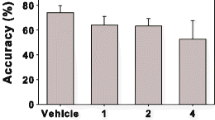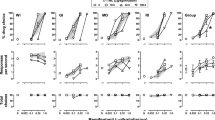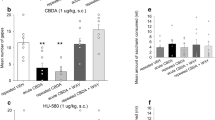Abstract
Rationale
A growing body of evidence suggests that cannabinoid CB1 receptor antagonists have potential therapeutic utility as appetite suppressants. However, the specific mechanisms underlying the reduction in food intake produced by these drugs are not well understood.
Objective
Considering the known antiemetic and motor-suppressive effects of CB1 agonists, the present studies were conducted to determine if the reductions in food intake induced by the CB1 antagonist AM 251 could result from nausea or impairments in intake-related motor control, rather than solely from appetite suppression.
Methods
Three experiments were conducted to examine the effects of AM 251 (2.0, 4.0, or 8.0 mg/kg or vehicle) on detailed parameters of food intake, on the development of conditioned taste avoidance, and on taste reactivity.
Results
In the first experiment, acute administration of AM 251 dose-dependently decreased food intake; nevertheless, feeding rate (grams consumed per time spent eating) and food handling were unaffected, which suggests that food intake was not reduced because of severe motor impairments. In the second experiment, AM 251 dose-dependently reduced intake of a flavor with which it had previously been associated, indicating that conditioned taste avoidance had developed. Lastly, AM 251 was found to induce conditioned rejection reactions in a dose-dependent manner.
Conclusions
The CB1 antagonist AM 251 may reduce food intake in part by inducing nausea or malaise, but not because of incoordination or motor slowing related to feeding.



Similar content being viewed by others
References
Abel EL (1971) Effects of marihuana on the solution of anagrams, memory and appetite. Nature 231:260–261
Arnone M, Maruani J, Chaperon F, Thiébot M-H, Poncelet M, Soubrié P, Le Fur G (1997) Selective inhibition of sucrose and ethanol intake by SR 141716, an antagonist of central cannabinoid (CB1) receptors. Psychopharmacology 132:104–106
Black SC (2004) Cannabinoid receptor antagonists and obesity. Curr Opin Investig Drugs 5(4):389–394
Clifton PG (2000) Meal patterning in rodents: psychopharmacological and neuroanatomical studies. Neurosci Biobehav Rev 24:213–222
Colombo G, Agabio R, Diaz G, Lobina C, Reali R, Gessa GL (1998) Appetite suppression and weight loss after the cannabinoid antagonist SR 141716. Life Sci 63:PL113–PL117
Compton DR, Aceto MD, Lowe J, Martin BR (1996) In vivo characterization of a specific cannabinoid receptor antagonist (SR141716A): inhibition of delta 9-tetrahydrocannabinol-induced responses and apparent agonist activity. J Pharmacol Exp Ther 277(2):586–594
Cousins MS, Sokolowski JD, Salamone JD (1993) Different effects of nucleus accumbens and ventrolateral striatal dopamine depletions on instrumental response selection in the rat. Pharmacol Biochem Behav 46:943–951
Dale L, Anthenelli R, Despres J-P, Golay A, Sjostrom L (2004) Effects of rimonabant in the reduction of major cardiovascular risk factors: results from the STRATUS-US Trial (Smoking cessation in smokers motivated to quit) and the RIO-LIPUDS Trial (Weight reducing and metabolic effects in overweight/obese patients with dyslipidemia). Presented at the Annual Scientific Session of the American College of Cardiology, New Orleans, LA
Darmani NA (2001) Delta-9-tetrahydrocannabinol and synthetic cannabinoids prevent emesis produced by the cannabinoid CB1 receptor antagonist/inverse agonist SR 141716A. Neuropsychopharmacology 24:198–203
Darmani NA, Johnson JC (2004) Central and peripheral mechanisms contribute to the antiemetic actions of delta-9-tetrahydrocannabinol against 5-hydroxytryptophan-induced emesis. Eur J Pharmacol 488(1–3):201–212
Darmani NA, Pandya DK (2000) Involvement of other neurotransmitters in behaviors induced by the cannabinoid CB1 receptor antagonist SR 141716A in naive mice. J Neural Transm 107:931–945
De Vry J, Schreiber R, Eckel G, Jentzsch KR (2004) Behavioral mechanisms underlying inhibition of food-maintained responding by the cannabinoid receptor antagonist/inverse agonist SR141716A. Eur J Pharmacol 483(1):55–63
Di Marzo V, Goparaju SK, Wang L, Liu J, Batkai S, Jarai Z, Fezza F, Miura GI, Palmiter RD, Sugiura T, Kunos G (2001) Leptin-regulated endocannabinoids are involved in maintaining food intake. Nature 410(6830):822–825
Foltin RW, Brady JV, Fischman MF (1986) Behavioral analysis of marijuana effects on food intake in humans. Pharmacol Biochem Behav 25:577–582
Freedland CS, Poston JS, Porrino LJ (2000) Effects of SR141716A, a central cannabinoid receptor antagonist, on food-maintained responding. Pharmacol Biochem Behav 67:265–270
Gatley SJ, Gifford AN, Volkow ND, Lan R, Makriyannis A (1996) 123I-labeled AM 251: a radioiodinated ligand which binds in vivo to mouse brain cannabinoid CB1 receptors. Eur J Pharmacol 307(3):331–338
Giuliani D, Ottani A, Ferrari F (2000) Effects of the cannabinoid receptor agonist, HU 210, on ingestive behaviour and body weight of rats. Eur J Pharmacol 391:275–279
Gómez R, Navarro M, Ferrer B, Trigo JM, Bilbao A, Del Arco I, Cippitelli A, Nava F, Piomelli D, Rodríguez de Fonseca F (2002) A peripheral mechanism for CB1 cannabinoid receptor-dependent modulation of feeding. J Neurosci 22:9612–9617
Gonzalez-Rosales F, Walsh D (1997) Intractable nausea and vomiting due to gastrointestinal mucosal metastases relieved by tetrahydrocannabinol (dronabinol). J Pain Symptom Manage 14(5):311–314
Grill HJ, Norgren R (1978) The taste reactivity test. I. Mimetic responses to a gustatory stimuli in neurologically normal rats. Brain Res 143:263–279
Halford JC, Wanninayake SC, Blundell JE (1998) Behavioral satiety sequence (BSS) for the diagnosis of drug action on food intake. Pharmacol Biochem Behav 61(2):159–168
Hart CL, Ward AS, Haney M, Comer SD, Foltin RW, Fischman MW (2002) Comparison of smoked marijuana and oral Δ9-tetrahydrocannabinol in humans. Psychopharmacology 164:407–415
Higgs S, Williams CM, Kirkham TC (2003) Cannabinoid influences on palatability: microstructural analysis of sucrose drinking after delta(9)-tetrahydrocannabinol, anandamide, 2-arachidonoyl glycerol and SR141716. Psychopharmacology 165(4):370–377
Hildebrandt AL, Kelly-Sullivan DM, Black SC (2003) Antiobesity effects of chronic cannabinoid CB1 receptor antagonist treatment in diet-induced obese mice. Eur J Pharmacol 462:125–132
Institute of Laboratory Animal Resources (1996) Guide for the care and use of laboratory animals. National Academy Press, Washington, DC
Jamshidi N, Taylor DA (2001) Anandamide administration into the ventromedial hypothalamus stimulates appetite in rats. Br J Pharmacol 134(6):1151–1154
Järbe TUC, Andrzejewski ME, DiPatrizio NV (2002) Interactions between the CB1 receptor agonist Δ9-THC and the CB1 receptor antagonist SR-141716 in rats: open field revisited. Pharmacol Biochem Behav 73:911–919
Jicha GA, Salamone JD (1991) Vacuous jaw movements and feeding deficits in rats with ventrolateral striatal dopamine depletions: possible relation to parkinsonian symptoms. J Neurosci 11:3822–3829
Kathmann M, Bauer U, Schlicker E, Gothert M (1999) Cannabinoid CB1 receptor-mediated inhibition of NMDA- and kainate-stimulated noradrenaline and dopamine release in the brain. Naunyn-Schmiedeberg’s Arch Pharmacol 359(6):466–470
Keppel G (1982) Design and analysis: a researcher’s handbook. Prentice-Hall, Englewood Cliffs, NJ
Limebeer CL, Parker LA (2000) The anti-emetic drug ondansetron interferes with lithium-induced conditioned rejection reactions, but not lithium-induced taste avoidance. J Exp Psychol Anim Behav Process 26(4):371–384
Limebeer CL, Parker LA (2003) The 5-HT1A agonist 8-OH-DPAT dose-dependently interferes with the establishment and the expression of lithium-induced conditioned rejection reactions in rats. Psychopharmacology 166(2):120–126
Limebeer CL, Parker LA, Fletcher PJ (2004) 5,7-Dihydroxytryptamine lesions of the dorsal and median raphe nuclei interfere with lithium-induced conditioned gaping but not conditioned taste avoidance in rats. Behav Neurosci 118(6)
Mayer LA, Parker LA (1993) Rewarding and aversive properties of IP versus SC cocaine: assessment by place and taste conditioning. Psychopharmacology 112:189–194
McLaughlin PJ, Winston K, Swezey L, Wisniecki A, Aberman J, Tardif DJ, Betz AJ, Ishiwari K, Makriyannis A, Salamone JD (2003) The cannabinoid CB1 antagonists SR 141716A and AM 251 suppress food intake and food-reinforced behavior in a variety of tasks in rats. Behav Pharmacol 14:583–588
Parker LA (1996) LSD produces a place preference and taste avoidance, but does not produce a taste aversion. Behav Neurosci 109:503–508
Parker LA (1998) Emetic drugs produce conditioned rejection reactions in the taste reactivity test. J Psychophysiol 12:3–13
Parker LA (2003) Taste avoidance and taste aversion: evidence for two different processes. Learn Behav 31:165–172
Parker LA, Mechoulam R (2003) Cannabinoid agonists and antagonists modulate lithium-induced conditioned gaping in rats. Integr Physiol Behav Sci 38:133–145
Parker LA, Mechoulam R, Schlievert C, Abbott L, Fudge ML, Burton P (2003) Effects of cannabinoids on lithium-induced conditioned rejection reactions in a rat model of nausea. Psychopharmacology 166(2):156–162
Patel S, Hillard CJ (2001) Cannabinoid CB(1) receptor agonists produce cerebellar dysfunction in mice. J Pharmacol Exp Ther 297(2):629–637
Rinaldi-Carmona M, Barth F, Héaulme M, Shire D, Calandra B, Congy C, Martinez S, Maruani J, Néliat G, Caput D et al (1994) SR141716A, a potent and selective antagonist of the brain cannabinoid receptor. FEBS Lett 350:240–244
Rogers PJ, Blundell JE (1979) Effect of anorexic drugs on food intake and the micro-structure of eating in human subjects. Psychopharmacology 66(2):159–165
Salamone JD, Zigmond MJ, Stricker EM (1990) Characterization of the impaired feeding behavior in rats given haloperidol or dopamine-depleting brain lesions. Neuroscience 39(1):17–24
Salamone JD, Mahan K, Rogers S (1993) Ventrolateral striatal dopamine depletions impair feeding and food handling in rats. Pharmacol Biochem Behav 44:605–610
Shearman LP, Rosko KM, Fleischer R, Wang J, Xu S, Tong XS, Rocha BA (2003) Antidepressant-like and anorectic effects of the cannabinoid CB1 receptor inverse agonist AM 251 in mice. Behav Pharmacol 14(8):573–582
Simoneau II, Hamza MS, Mata HP, Siegel EM, Vanderah TW, Porreca F, Makriyannis A, Malan TP Jr (2001) The cannabinoid agonist WIN55,212-2 suppresses opioid-induced emesis in ferrets. Anesthesiology 94:882–887
Van Sickle MD, Oland LD, Mackie K, Davison JS, Sharkey KA (2003) Δ9-tetrahydrocannabinol selectively acts on CB1 receptors in specific regions of dorsal vagal complex to inhibit emesis in ferrets. Am J Physiol Gastrointest Liver Physiol 285:G566–G576
Williams CM, Kirkham TC (1999) Anandamide induces overeating: mediation by central cannabinoid (CB1) receptors. Psychopharmacology 143:315–317
Williams CM, Kirkham TC (2002) Observational analysis of feeding induced by Δ9-THC and anandamide. Physiol Behav 76:241–250
Acknowledgements
This research was supported by a grant to J.D.S. and A.M. from the US NIH/NDA.
Author information
Authors and Affiliations
Corresponding author
Rights and permissions
About this article
Cite this article
McLaughlin, P.J., Winston, K.M., Limebeer, C.L. et al. The cannabinoid CB1 antagonist AM 251 produces food avoidance and behaviors associated with nausea but does not impair feeding efficiency in rats. Psychopharmacology 180, 286–293 (2005). https://doi.org/10.1007/s00213-005-2171-0
Received:
Accepted:
Published:
Issue Date:
DOI: https://doi.org/10.1007/s00213-005-2171-0




